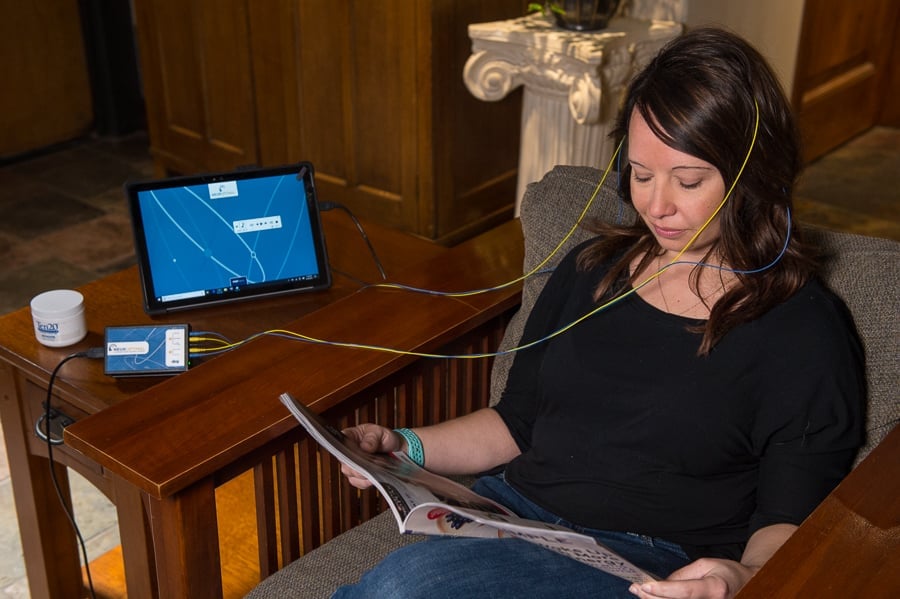How to manage your stress: worrying is on the rise
Worrying is on the rise and that was even before the COVID-19 pandemic. If you look at the graph you'll see how much more Americans are worrying today versus ten years ago, a rise of over 150%! "Over the past eight years Google searches of the word 'anxiety' have more than doubled," noted researcher, Seth Stephens-Davidowitz in his New York Times opinion piece on anxiety in America. Statistics indicate that worry is officially the most common mental condition in the United States.
Worrying is connected to stress. Noticing that our thoughts are primarily about problems is one of the best signs that we are not managing our stress well. The good news is that we can intervene and learn tools for stress management. First we have to understand why the brain creates stress, it is part of our body's defensive structure, and how it switches from bringing us benefit to becoming a major contributor to being unhealthy and unhappy.
What is Stress?
Stress is our body’s bio-physiological reaction to stressors. Stressors are information that are registered as threat or danger to our immediate well-being and survival. The brain communicates to the body's different systems to make changes through hormones, muscle tone, breathing, the digestive system, to be in alignment with the perceived danger and how the body may need to react to stay safe. This information may be from ourselves or our environments, which can range from simple daily challenges to serious life-threatening events, but the key is that the body responds to as in the category of "threat/danger," which it may or may not actually be. Often the body going into a stress response is based on perception, or rather mis-perception, rather than what is actually happening. For example, being told by our boss that we didn't do our best work on a project (low threat) is different from being fired and never again finding work (high life threat), but unfortunately our bodies will often produce stress hormones in amount and longevity that reflect the latter rather than the former event.
The effect stress has on our health depends on the way we react to it. In a perceived highly stressful situation, our ‘fight or flight’ response is invoked. Hormones such as cortisol and adrenalin (so-called ‘stress hormones’) are released, blood rushes to specific muscles (to enable us to fight against or flee from an enemy) and we feel a burst of energy and strength. This response is useful when we are up against a real threat, however, when it is invoked when we are not actually in danger, it has detrimental effects on our health and mental well-being.
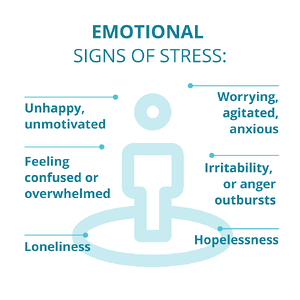
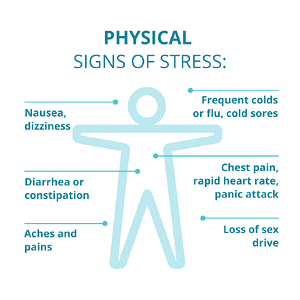
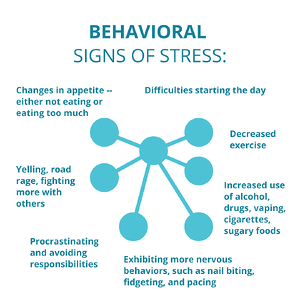
Signs of stress
Wondering if your body is too often in an unhealthy stress response? Here are the top signs of stress you can look for in your life:
- Having difficulty managing your sleep. Waking up too early and not falling back to sleep. Waking up and immediately thinking of things that worry you.
- Always feeling like you're in go-mode and using substances like alcohol or pot to down-shift at the end of the day.
- Easy to anger.
- Stomach troubles, upset stomach, digestive issues.
- Having a hard time concentrating or focusing on one thing, mind racing, and having difficulty sitting still
- Being unmotivated to do things unless you need to. Having low energy and not motivated to engage in life's activities.
- Unable to laugh, be creative or feel joy.
How much stress do we have to manage?
How much stress we have to manage has a lot to do with our unconscious brain's reaction to what it perceives as stressors or threats to the body's safety. It's not that you consciously created the stress reaction. How much work you have to do to manage your stress depends on the brain's habituation to creating a stress response.
There are three states, or zones, that make up the unconscious stress response cycle. The brain goes in and out of these states in the course of the hours and days of your life. Your physical, emotional and mental wellbeing all depend on what zone your brain habitually hangs out in. Two of the zones--fight/flight and the freeze/collapse zones-- use a huge amount of energy to maintain, and cause a lot of wear on our bodies (as analogue, think of the wear caused by sprinting a marathon-length course).
-Dec-19-2022-11-34-47-7459-PM.png?width=555&name=THE%20STRESS%20RESPONSE%20-%203%20zones-fight-flight%20(1)-Dec-19-2022-11-34-47-7459-PM.png)
What are the 3 stages of the stress response?
This is a simplistic diagram of what the protective part of the brain, which controls the stress response, is meant to do through-out the day as it perceives objects, people and events. In Zones 1 and 3 the brain is perceiving the current situation as a threat in some way and therefore, the limbic brain goes on auto-pilot and immediately sends 'stress response' signals through electrical communication and chemical signals for the body to go either into anxious/angry strategy to attack or flee the threatening event. If the brain chooses zone 3 as it's stragedy, it will signal to the system to shut down and "play dead" as a survival strategy.
We manage stress to create a Healthy Brain Response
A healthy brain is meant to be in zone 2 as "home base" and go up into fight/flight (zone 1) or down into the freeze response (zone 3) only when it identifies the 'other' as a threat of some sort. For the protective brain, which controls the stress response, the definition of threat or danger is very specific: is this THING is going to cause bodily harm in less than a minute? If it concludes 'yes' then it will make a flash decision in mili-seconds to either: fight it, run from it, or play dead. Not a very wide range, but it historically has got the job done to keep our bodies alive. And then the brain is meant to immediately return to zone 2's calm and open state upon resolving the threat. Calm, perceive threat, attack, then calm again. Calm then freeze, then calm again. And that's the strategy for how our protective brain has kept us alive for thousands of years.
Of course, we all noted when we looked at those three zones that we don't live in zone 2 most of the time. We find our home base to be a combination of anxious/ depressive with a touch of calm, maybe, after a long walk in the woods. Or we'll use alcohol to force ourselves out of that anxious / angry Zone 1. Why is that?
What we have come to understand in the study of the stress response and the brain is that there is an unfortunate event that happens when the brain is attempting to be efficient in its use of energy: it generalizes. And when the brain generalizes: "Oh, I know this person, just like dad (not safe)..." it becomes habituated and stupid, producing a stress response when there is no actual danger. And we experience, as example, not just momentary fear in response to a new person but chronic anxiety in social situations.
The brain is designed to use energy efficiently. The stress response is "sprint" energy. Life is a marathon. So when the brain trains in being alerted to use real-time, present moment data to make decisions it sees that sprinting isn't the best energy for life when there is no immediate danger. As a result, those stress response symptoms: worry , fear, agitated, irritation, difficulties in falling a sleep pr staying a sleep, and even focus and attention issues in children, start to shift. And those maladaptive responses are replaced with what's appropriate for the here-and-now. Neurofeedback can train the brain to respond in a positive manner to challenging situations besides using the stress response. Our best defense is awareness. Watch this video to learn about the three zones.
-4.png?width=495&name=NFT-Signs-of-Stress-HOW%20TO%20%20BOOST%20WELLNESS%20(1)-4.png)
What do we do about this habituation of the brain?
Read more about how to help decrease stress.
One of our greatest tools for change is self-awareness. First we need to take a step back, take a deep breath, then look at our patterns, then we have the opportunity to make different choices. Whenever we identify someone or a situation as unsafe, for the automatic functioing brain, it hears: go into a stress reaction because something's about harm you physically. The reality is that regardless of how mean your boss is, how jealous your best friend is, how low your bank balance is, you are safe. You may have just said "Ya, but...." and given a reason, probably very legitimately so, about how the above are problems, but that is very different than unsafe. Problems are solved with a very different part of the brain than dangerous threats. The pre-frontal cortex solves problems. The limbic brain/brainstem solve dangers. And if you're ever confused about whether the stress response is the right strategy just ask yourself this question: would it help solve the problem to punch it, run from it or play dead? If the answer is no then take a deep breath, or 10 or 20.
Read Also
Mindfulness for Anxiety Performance - Does Meditation Work?
What stress does to the brain for Children
When a child is exposed to unsafe people and situations, which includes being neglected, the brain becomes habituated to a stress response, which is now called "complex trauma / PTSD". If you are someone who has had childhood trauma or diagnosed with PTSD, reading the work of Dr. Basel Van Der Kolk and his book The Body Keeps the Score, is a great education.
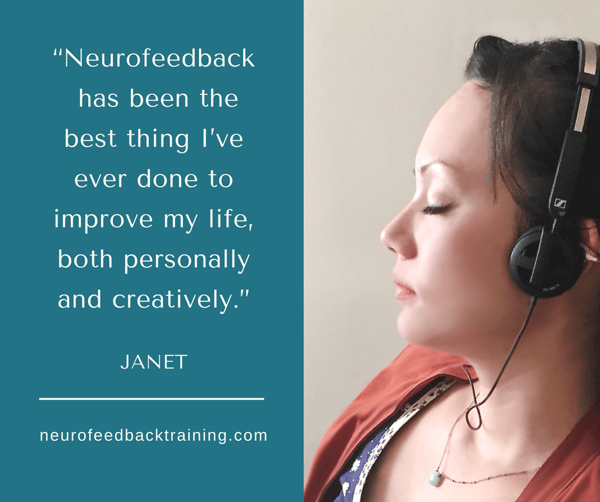
Neurofeedback Training for Stress Management
Neurofeedback training is an effective brain training method to cope with stress. As one of our clients in California stated: "Neurofeedback has been a great way for me to deal manage my stress better. I feel more calm, alert and can engage more intimately with the present moment." The NeurOptimal® Neurofeedback System is a fully automated neurofeedback technology and can also be rented or purchased for home use. We also provide neurofeedback sessions in NYC, Los Angeles/Pasadena, Denver and Boulder. The neurofeedback home system rentals are just as effective training as in-office visits and we ship the equipment directly to your home. Learn more about renting a home unit here or use the Chat Widget in the lower corner to chat with one of our neurofeedback trainers.
